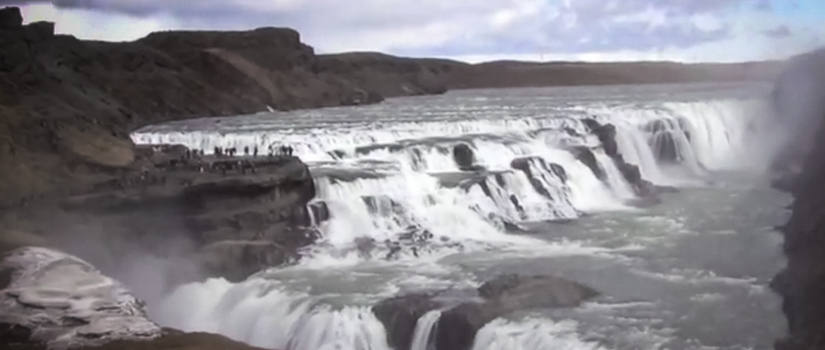Author
Chandler Green
Faculty Mentor
Laura Kissel
The mainstream media frequently promote sensational stories about controversial environmental topics such as clean energy and global warming. But it is difficult to understand the significance of these issues and find ways to solve these environmental problems without experiencing their complexity firsthand. This was the motivation behind our desire to research Iceland, because it is a living laboratory for the most prominent environmental issues of the 21st century. Iceland is known for being one of the “greenest” countries in the world, with eighty percent of its energy derived from clean energy sources. However, it is also confronts the threat of global warming, as its glaciers are rapidly melting.
In May 2013, we traveled to Iceland in order to experience first hand and document the effects of climate change on Iceland’s environment and the country’s responsive efforts to use clean energy. The driving purpose behind the documentary was to better understand Iceland’s relationship with their environment, and how climate change threatens this relationship. The medium of film was used to illustrate the investigation in order to personally share the learning experience. Using filmed interviews with University of Iceland students, representatives from the United Nations University Geothermal and Land Restoration Training Programs, and tour guides, firsthand knowledge was captured and communicated from the residents of Iceland themselves. Ultimately the documentary aims to educate viewers on relevant environmental issues in Iceland from the role of geothermal energy in the country to its rapidly melting glaciers. Such visual environmental education is essential because these issues currently modeled by Iceland will soon be the responsibility of our generation.
Although the current documentary conclusion sufficiently summarizes the main points of the environmental lessons learned in Iceland, it does not engage viewers to take responsibility of the planet. A stronger conclusion to the documentary would have been developed with additional footage and with more post-production reflection; such a conclusion would impart an imminent forewarning to the consequences of climate inaction. This would be achieved in a revised cut with a fast paced montage of video and audio from news reports mixed with footage from Iceland. Similar to the building news reports that open the documentary, a montage at the film’s conclusion would convey the urgent nature of acting on these same global environmental issues experienced firsthand in Iceland. Powerful calls to action are essential to connecting the film’s message to viewers and will not be undervalued in future documentary films.
About the Author
 Chandler Green
Chandler Green
I am a sophomore environmental science major from Rock Hill, S.C., and I received the Magellan Apprentice grant with my research partner Caitlyn Gilbert. Together we chose to film a documentary during our Maymester in Iceland because the country is a living laboratory for the most prominent environmental issues of our time. I have presented “Sustaining the Land of Fire and Ice” at the department of Earth and Ocean Science’s welcome back event and have had a viewing for the Iceland Maymester class. The documentary is currently featured on the Office of Undergraduate Research’s website and the Environment and Sustainability Program’s website. The impacts from this project cannot be understated. I had the opportunity to interview professionals at the United Nations Geothermal Training Program and the United Nations Land Restoration Program, and to learn personally from many other knowledgeable Icelanders. The even bigger takeaway for me was discovering documentary film’s powerful ability to educate others. In fact, I believe that using film to expose climate change would greatly enhance the public’s understanding of this complex issue. Completing “Sustaining the Land of Fire and Ice” has motivated me to further use documentary film to interpret environmental information for the public. Of course this project would not have been possible without my good friend, research partner and co-filmmaker Caitlyn Gilbert. I would like to thank my supportive mentor, Laura Kissel of the Media Arts department, for guiding us through the documentary process. I would also like to thank the Iceland Maymester faculty: Jeannie Weingarth, Natalie Cruz and Asheley Schryer, for our incredible experience researching abroad. Special thank you to the Magellan Apprentice program for giving us the funds we needed to complete our documentary.
References
Ægisdóttir Hafdís H. Director of the UNU-LRT. Personal Interview. 20 May 2013.
“Energy Statistics in Iceland 2012.” Orkustofnun, Jan. 2013. Web. 4 Mar. 2013. <http://www.os.is/gogn/os-onnur-rit/orkutolur_2012-enska.pdf>.
Georgsson, Ludvik S. Deputy Director of the UNU-GTP. Personal Interview. 17 May 2013.
Guttormsdóttir, Berglind O. Extreme Iceland Tour Guide. Personal Interview. 14 May 2013.
Hermannsson, Jón A. University of Iceland Student. Personal Interview. 15 May 2013.
Jónsson, Ragnar P. Extreme Iceland Tour Guide. Personal Interview. 16 May 2013.
Kristinsdóttir, María R. University of Iceland Student. Personal Interview. 15 May 2013.
